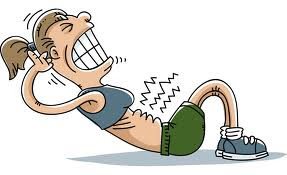Sit-Ups: Good or Bad?
After beginning abdominal training in physical therapy, one of the first questions I get is:
“When can I do a sit-up?”
Sit-ups have a long history of being the golden ticket for awesome abdominal strength and aesthetics. Although there are better movements to effectively train the abdominals, sit-ups are A-OK and have a functional application. If you’re lying on the floor and want to get up, most of us perform a sit-up to make that change in position. But, there is a correct way to do a sit-up in order to protect the spine and avoid injury or pain.
Blog Activity
Lay on the floor, place your palms next to your side and perform a sit-up. Look down at your abdominals.
Does it look like this?
Or this?
If your abdominals look like picture 1, this blog is for you! Notice the bulge in picture 1 compared to picture 2. (That bulge is a muscular bulge not a fat bulge…I know what you are thinking!). The bulge indicates that the transverse abdominis is not activated.
We have four layers of abdominals. Yes, 1-2-3-4. The first layer acts as a stabilizer, the second layer acts as a stabilizer and mover, the third and fourth layer act as movers. In the previous post, I mentioned the importance of having stability for efficient mobility. A sit-up requires the same principles. It is imperative to have the inner layers stabilizing the spine in order for the outer layers to move the trunk; this combination is the key for a safe sit-up.
Here is a very brief review of the abdominal layers from deepest to superficial:
Layer 1: Transverse Abdominis: muscle fibers wrap around from the back to the front like a corset. Activation of this muscle causes the pressure inside the abdominal cavity to increase, creating stabilization to the spine. (STABILIZER)
Layer 2: Internal Abdominal Oblique: muscle fibers run in a diagonal direction. Activation of this muscle increases the pressure inside the abdominal cavity to assist with spine stabilization and causes rotation and side bending of the trunk. (STABILIZER AND MOVER)
Layer 3: External Abdominal Oblique: muscle fibers run in the opposite diagonal direction from the internal obliques. Activation of this muscle causes rotation and side bending of the trunk and tilts the pelvis so the back lays flat on the floor (posterior pelvic tilt). (MOVER)
Layer 4: Rectus Abdominis: muscle fibers run up and down, with dividers in the muscle called tendinous intersections. These dividers give the 6-pack formation. This muscle flexes the trunk (sit-up) and tilts the pelvis. (MOVER)
If the inner layers are working properly to stabilize, the belly will flatten and create a scoop or bowl shape without any movement of the pelvis. Mastering this deep abdominal connection takes time, but it is essential for optimal function and sport and to balance the gross motor strength of the outer abdominal layers.
Supine Stability Activation
- Lay on your back
- Bend your knees with feet flat on floor
- Find neutral pelvis so hip bones are parallel with floor
- Place first two fingers on the inside of your hip bones and draw the belly in
- Feel for muscles to “poke” into your fingers; those muscles are the transverse abdominis and internal oblique activating for stability.
IF YOU CAN’T DO THIS…
YOU SHOULDN’T BE DOING THIS!
© 2014 and Beyond. ALL BLOG CONTENT at duncansportspt.com by Lori Duncan PT






